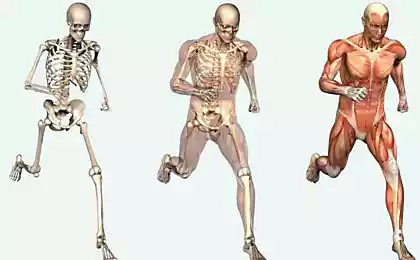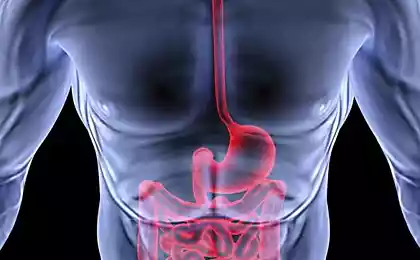727
5 types of diets that help get rid of diseases
Despite the fact that the diets usually come running when they want to lose weight, the pursuit of slender figure is not the only real purpose diets. Some of them needed to improve blood pressure and health in General. We offer you 5 types of diets that prevent illness and enhance health.

photo: www.amitfarber.com
The diet is based on foods with a low glycemic index
With a diet should avoid carbohydrates, which can lead to a rapid rise in blood sugar. The diet focuses on consuming "good" carbohydrates that help keep blood sugar normal.
Foods that can be eaten — products with a low glycemic index such as bread from coarse wholemeal rye flour, oat flakes, oat bran, pasta, parboiled rice, seeds, quinoa, beans, peas, lentils and nuts. Also suggest to eat more fruits and vegetables, and few potatoes.
The diet is based on foods with a low glycemic index use when they want to lose weight, for example, in this case interesting diet Nutrisystem or the Zone diet. These diets work well when a person has type II diabetes or has a predisposition to diabetes. They help to control the sugar level in the blood and reduce the risk of diabetes, also increase the level of high density lipoprotein (good cholesterol) and reduce the risk of cardiovascular diseases.
In 2008 in the journal of the American Medical Association (Journal of the American Medical Association)published the results of the studies, which were attended by 210 people, sitting on a diet for 6 months. It turned out that these types of diets were the most effective for regulating blood sugar than a diet that included foods such as wheat bread flour wholemeal grain or pneumatic flour, Breakfast cereals whole grains, brown rice, jacket potatoes and more.
A vegetarian diet
Vegetarian diets are widely used by many people on cultural, religious or environmental beliefs, but these types of diets have beneficial health effects. Soglasheniyami Association of Heart Disease (American Heart Association), studies have shown that vegetarians seem to have lower risks of overweight, coronary heart disease, high blood pressure and diabetes.
People who adhere to vegetarian diets, even those that allow the use of eggs and dairy products, eat less fat high in saturated fatty acids and cholesterol and more carbohydrates, fruit and vegetable fiber, magnesium, folic acid, vitamins C and b, and carotenoids.
National Institute of Health (National Institutes of Health)warns vegetarians that their diet should be carefully balanced so it will not lack in fundamental vitamins and proteins.
DASH diet
DASH is the acronym that means "diet to get rid of hypertension". This diet was proposed by the National Institute of Heart, Lung, and Blood (National Heart Lung and Blood Institute) and helps to lower blood pressure. The meal plan in this diet is quite easy — the list of allowed foods includes vegetables, fruits, fat free or low fat dairy products, cereal whole grains, fish, poultry, beans and nuts. When this diet is also to reduce the consumption of salt, sugar, fats and red meat.
There are no special recipes, but a daily intake of calories and the portion size depends on a person's age and level of physical activity.
Blood pressure in this diet falls very quickly, in two weeks has already seen significant results. Research conducted by Duke University (Duke University) in 2010, involving 144 patients with obesity, showed that only one of this diet may decrease systolic blood pressure by 11 points and diastolic pressure by 7 points. The DASH diet together with exercise can reduce systolic blood pressure by 16 points and diastolic pressure by 10 points.
These same studies have shown that in addition to normalize blood pressure, DASH diet along with exercise can greatly improve insulin sensitivity in people suffering from overweight or obesity. Another study conducted in 2010 by the Johns Hopkins University (Johns Hopkins University) showed that this diet may reduce the risk of coronary heart disease by 18 percent in people with prehypertension or hypertension the first stage.
The diet is based on foods with a low content or gluten free
Gluten (gluten) is the protein contained in cereals such as wheat, barley and rye. Diets that reduce the consumption of gluten, and are assigned to people suffering from celiac disease in which the immune system reacts to gluten because it gives irritation or even contributes to damage of the small intestine. This prevents absorption of such essential components like vitamins, calcium, proteins, fats and carbohydrates.
In addition, you need to avoid wheat, barley and rye, people sitting on a diet, exclude from the diet of many types of bread, pasta, cereals and processed foods.
Sometimes you can find claims that products that do not contain gluten, can improve the behavior of people with autism, however, is scientifically not yet proven.
In 2010 in the journal Pediatrics by Harvard Medical School published the opinion of some scholars, who argued that although gastrointestinal diseases and related symptoms appear in people with autism, the relationship of autism and gluten not yet been identified.
Also has not yet been any study that found that such diet is based on foods without gluten, have a positive effect on health, in addition, that help to get rid of celiac disease.
Ketogenic diet
Ketogenic diet – this diet is not for everyone. Actually, this very special and carefully balanced diet is meant for people suffering from epilepsy (especially for children), for whom drugs.
Those who are assigned to follow this diet should strictly monitor the use of fats, proteins and carbohydrates. Their diet should include 80 percent fat, 15 percent protein and 5 percent carbs.
The nutrition plan is developed strictly individually for each patient and may include a thick, heavy cream, bacon, tuna, shrimp, vegetables, mayonnaise, sausages and other foods rich in fats and contain minimal amount of carbohydrates. Patients not recommend eating starchy vegetables and fruits, bread, pasta, or foods containing sugar. Even toothpaste in rare cases, contain some amount of sugar! According to the Mayo Clinic (Mayo Clinic), there may be side effects – constipation, dehydration, low energy levels and hunger.
Despite the fact that this diet is very specific, it helps fight epilepsy. Study 2008, published in the journal The Lancet, showed that children who are assigned to such a diet decreases the number of seizures more than 3 times, compared to those who do not adhere to such diets.
In 28 of the 54 children who were sitting on a ketogenic diet for three months, decreased the number of seizures by 50 percent, and 5 children from this group are 90%.
To adhere to such a diet is very difficult, as it is quite strict and it has side effects. published
P. S. And remember, only by changing their consumption — together we change the world! ©
Source: www.infoniac.ru/news/5-vidov-diet-kotorye-pomogayut-izbavit-sya-ot-boleznei.html

photo: www.amitfarber.com
The diet is based on foods with a low glycemic index
With a diet should avoid carbohydrates, which can lead to a rapid rise in blood sugar. The diet focuses on consuming "good" carbohydrates that help keep blood sugar normal.
Foods that can be eaten — products with a low glycemic index such as bread from coarse wholemeal rye flour, oat flakes, oat bran, pasta, parboiled rice, seeds, quinoa, beans, peas, lentils and nuts. Also suggest to eat more fruits and vegetables, and few potatoes.
The diet is based on foods with a low glycemic index use when they want to lose weight, for example, in this case interesting diet Nutrisystem or the Zone diet. These diets work well when a person has type II diabetes or has a predisposition to diabetes. They help to control the sugar level in the blood and reduce the risk of diabetes, also increase the level of high density lipoprotein (good cholesterol) and reduce the risk of cardiovascular diseases.
In 2008 in the journal of the American Medical Association (Journal of the American Medical Association)published the results of the studies, which were attended by 210 people, sitting on a diet for 6 months. It turned out that these types of diets were the most effective for regulating blood sugar than a diet that included foods such as wheat bread flour wholemeal grain or pneumatic flour, Breakfast cereals whole grains, brown rice, jacket potatoes and more.
A vegetarian diet
Vegetarian diets are widely used by many people on cultural, religious or environmental beliefs, but these types of diets have beneficial health effects. Soglasheniyami Association of Heart Disease (American Heart Association), studies have shown that vegetarians seem to have lower risks of overweight, coronary heart disease, high blood pressure and diabetes.
People who adhere to vegetarian diets, even those that allow the use of eggs and dairy products, eat less fat high in saturated fatty acids and cholesterol and more carbohydrates, fruit and vegetable fiber, magnesium, folic acid, vitamins C and b, and carotenoids.
National Institute of Health (National Institutes of Health)warns vegetarians that their diet should be carefully balanced so it will not lack in fundamental vitamins and proteins.
DASH diet
DASH is the acronym that means "diet to get rid of hypertension". This diet was proposed by the National Institute of Heart, Lung, and Blood (National Heart Lung and Blood Institute) and helps to lower blood pressure. The meal plan in this diet is quite easy — the list of allowed foods includes vegetables, fruits, fat free or low fat dairy products, cereal whole grains, fish, poultry, beans and nuts. When this diet is also to reduce the consumption of salt, sugar, fats and red meat.
There are no special recipes, but a daily intake of calories and the portion size depends on a person's age and level of physical activity.
Blood pressure in this diet falls very quickly, in two weeks has already seen significant results. Research conducted by Duke University (Duke University) in 2010, involving 144 patients with obesity, showed that only one of this diet may decrease systolic blood pressure by 11 points and diastolic pressure by 7 points. The DASH diet together with exercise can reduce systolic blood pressure by 16 points and diastolic pressure by 10 points.
These same studies have shown that in addition to normalize blood pressure, DASH diet along with exercise can greatly improve insulin sensitivity in people suffering from overweight or obesity. Another study conducted in 2010 by the Johns Hopkins University (Johns Hopkins University) showed that this diet may reduce the risk of coronary heart disease by 18 percent in people with prehypertension or hypertension the first stage.
The diet is based on foods with a low content or gluten free
Gluten (gluten) is the protein contained in cereals such as wheat, barley and rye. Diets that reduce the consumption of gluten, and are assigned to people suffering from celiac disease in which the immune system reacts to gluten because it gives irritation or even contributes to damage of the small intestine. This prevents absorption of such essential components like vitamins, calcium, proteins, fats and carbohydrates.
In addition, you need to avoid wheat, barley and rye, people sitting on a diet, exclude from the diet of many types of bread, pasta, cereals and processed foods.
Sometimes you can find claims that products that do not contain gluten, can improve the behavior of people with autism, however, is scientifically not yet proven.
In 2010 in the journal Pediatrics by Harvard Medical School published the opinion of some scholars, who argued that although gastrointestinal diseases and related symptoms appear in people with autism, the relationship of autism and gluten not yet been identified.
Also has not yet been any study that found that such diet is based on foods without gluten, have a positive effect on health, in addition, that help to get rid of celiac disease.
Ketogenic diet
Ketogenic diet – this diet is not for everyone. Actually, this very special and carefully balanced diet is meant for people suffering from epilepsy (especially for children), for whom drugs.
Those who are assigned to follow this diet should strictly monitor the use of fats, proteins and carbohydrates. Their diet should include 80 percent fat, 15 percent protein and 5 percent carbs.
The nutrition plan is developed strictly individually for each patient and may include a thick, heavy cream, bacon, tuna, shrimp, vegetables, mayonnaise, sausages and other foods rich in fats and contain minimal amount of carbohydrates. Patients not recommend eating starchy vegetables and fruits, bread, pasta, or foods containing sugar. Even toothpaste in rare cases, contain some amount of sugar! According to the Mayo Clinic (Mayo Clinic), there may be side effects – constipation, dehydration, low energy levels and hunger.
Despite the fact that this diet is very specific, it helps fight epilepsy. Study 2008, published in the journal The Lancet, showed that children who are assigned to such a diet decreases the number of seizures more than 3 times, compared to those who do not adhere to such diets.
In 28 of the 54 children who were sitting on a ketogenic diet for three months, decreased the number of seizures by 50 percent, and 5 children from this group are 90%.
To adhere to such a diet is very difficult, as it is quite strict and it has side effects. published
P. S. And remember, only by changing their consumption — together we change the world! ©
Source: www.infoniac.ru/news/5-vidov-diet-kotorye-pomogayut-izbavit-sya-ot-boleznei.html























